
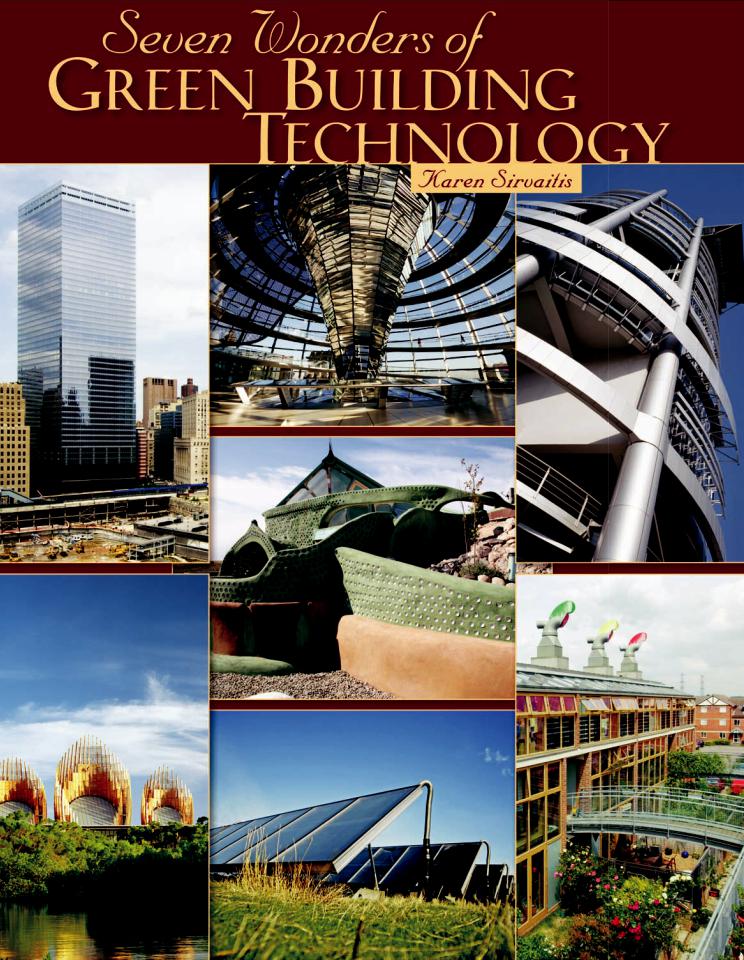

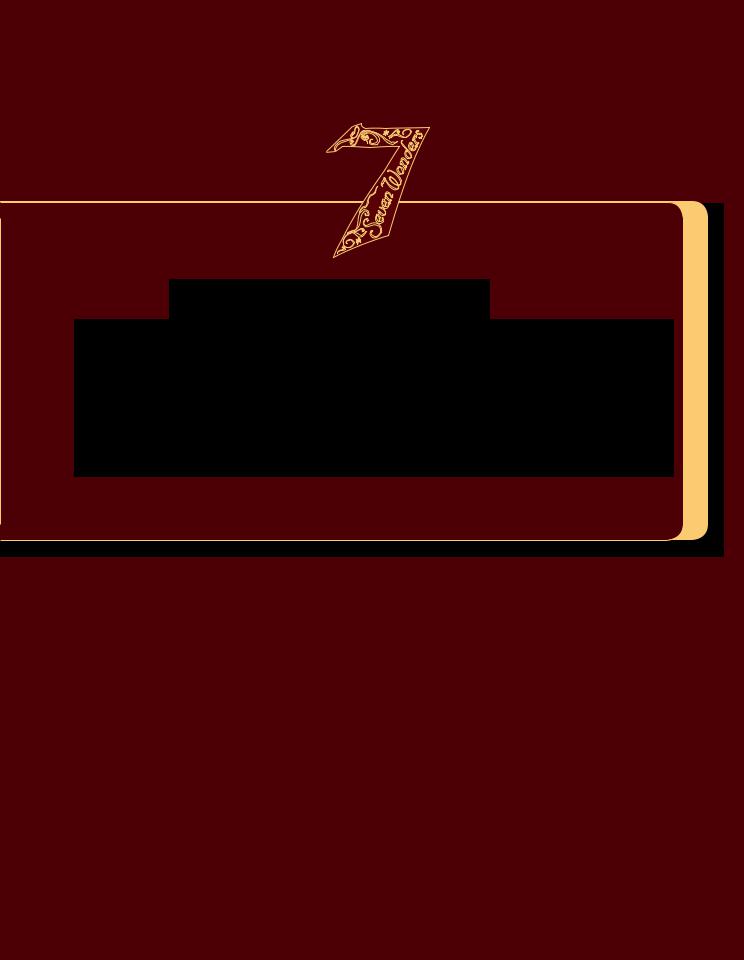
Seven Wonders of
Green Building
Technology
Karen Sirvaitis
Twenty-First Century Books
Minneapolis
BedZED
1

Seven Wonders of Green Building Technology
2
Copyright © 2010 by Karen Sirvaitis
All rights reserved. International copyright secured. No part of this book may be reproduced, stored in a retrieval system, or transmitted in any form or by any means—electronic, mechanical, photocopying, recording, or otherwise—without the prior written permission of Lerner Publishing Group, Inc., except for the inclusion of brief quotations in an acknowledged review.
Twenty-First Century Books
A division of Lerner Publishing Group, Inc. 241 First Avenue North
Minneapolis, MN 55401 U.S.A.
Website address: www.lernerbooks.com
Library of Congress Cataloging-in-Publication Data
Sirvaitis, Karen, 1961–
Seven wonders of green building technology / by Karen Sirvaitis.
p.cm. — (Seven wonders)
Includes bibliographical references and index. ISBN 978–0–7613–4242–7 (lib. bdg. : alk. paper)
1. Sustainable buildings—Juvenile literature. 2. Sustainable construction—Juvenile literature. I. Title.
TH880.S58 |
2010 |
|
720’.47—dc22 |
2009020317 |
|
Manufactured in the United States of America 1 – DP – 12/15/09
eISBN: 978-0-7613-5991-3

Contents
Introduction —— 4
BedZED —— 7
Earthships —— 19
Menara Mesiniaga —— 29
The Reichstag —— 39
7 World Trade Center —— 49
Jean-Marie Tjibaou Cultural Center —— 57
Samso —— 65
Timeline —— 72
Choose an Eighth Wonder —— 73 Glossary and Pronunciation Guide —— 74 Source Notes —— 75
Selected Bibliography —— 76 Further Reading and Websites —— 77 Index —— 78
BedZED
3

Introduction
People love to make lists of the biggest
and the best. Almost twenty-five hundred years ago, a Greek
writer named Herodotus made a list of the most awesome
things ever built by people. The list included buildings,
statues, and other objects that were large, wondrous, and
impressive. Later, other writers added new items to the list.
Writers eventually agreed on a final list. It was called the
Seven Wonders of the Ancient World.
The list became so famous that people began imitating it. They made other lists of wonders. They listed the Seven Wonders of the Modern World and the Seven Wonders of the Middle Ages. People even made lists of undersea wonders.
Going Green
This book is about the Seven Wonders of Green Building Technology. People often use the word green to describe things that are good for nature and the environment. When people stop doing something that pollutes the environment, they say they’re “going green.” Other terms to describe things that are good for the environment are Earth friendly, eco-friendly, and environmentally friendly.
Technology is another word for tools. People use certain tools, such as bulldozers and cranes, to construct buildings. They use other tools, such as heating, air-conditioning, electrical, and water systems, to keep buildings running. The term building technology refers to all the machines and techniques people use to construct and operate buildings.
4
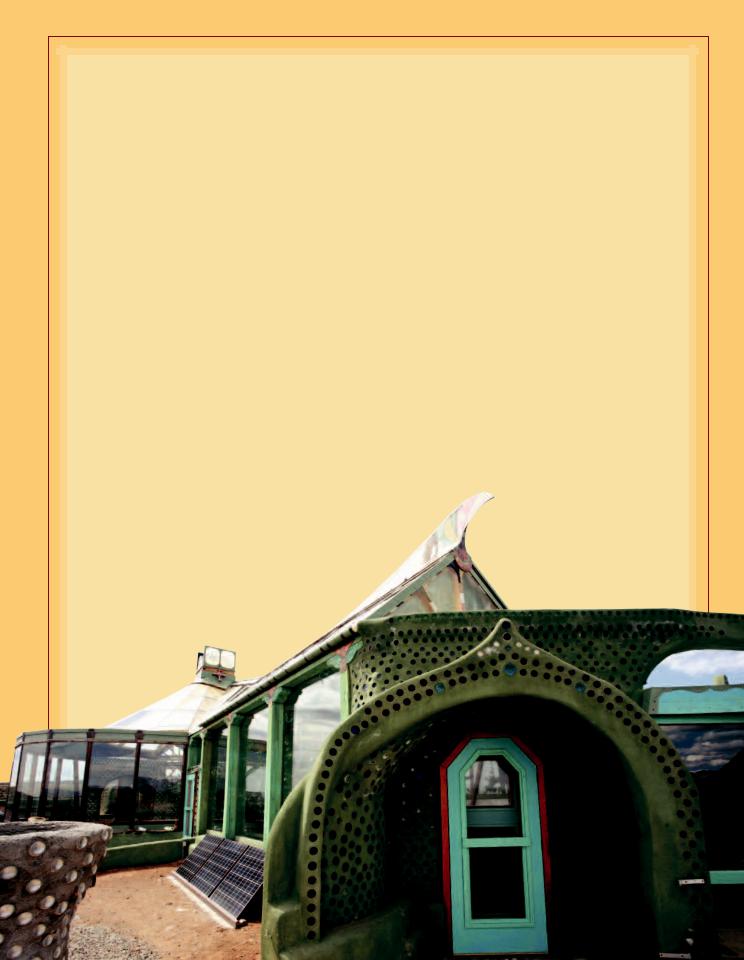
Some building technology can hurt the environment. Most buildings create pollution by using up a lot of energy and resources. The goal of green building technology is to make buildings and even whole communities that save energy and resources and that work in harmony with the environment.
Fantasy in Green
Imagine a world where, every day, you and everyone else are making a positive difference. In this world, almost everything you use can be recycled, or used again. Things that can’t be recycled break down into soil in your backyard compost heap. Your home and school use heating and cooling systems that rely on clean energy—the kind of energy that does not create pollution. Your family’s car is made in an eco-friendly factory. It also runs on clean energy.
This scenario is not just a fantasy. In this book, you’ll learn about seven green construction projects that are bringing us closer to this kind of world. You’ll read about buildings that get their energy from the sun. You’ll learn about houses made from recycled materials. You’ll learn how people use rain and wind to make buildings cooler, cleaner, and more Earth friendly. These projects are in North America, Europe, and Asia. They
show that people all around the world want to create a cleaner environment. Read on to visit this new world of green construction.
5
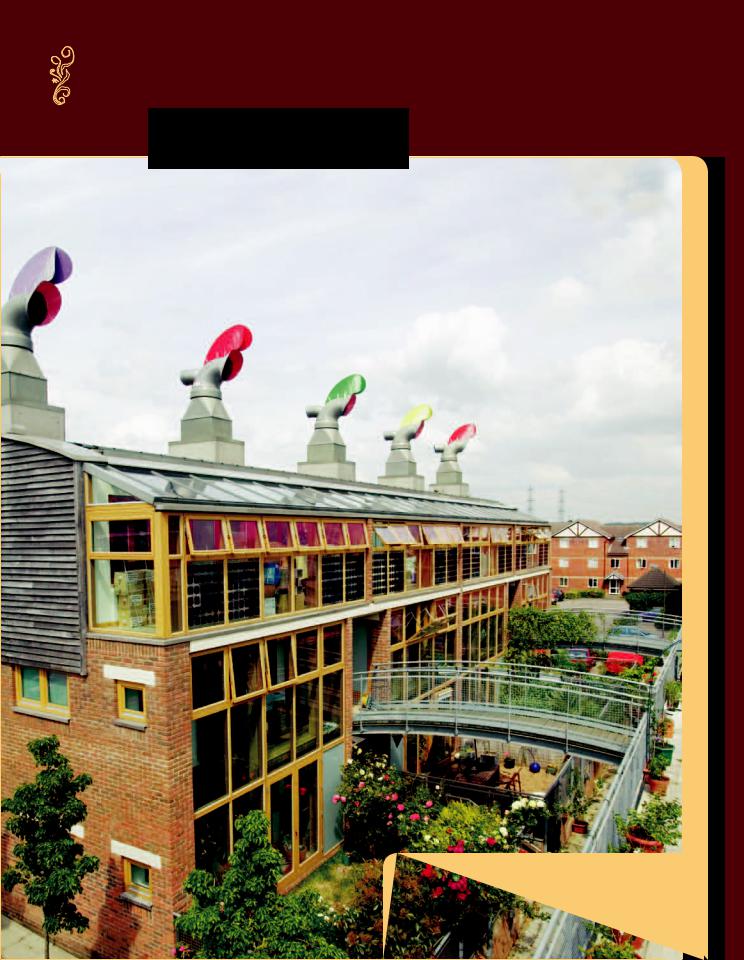
 BedZED
BedZED
People living in BedZED use fewer natural resources than their neighbors. BedZED dwellers use 81 percent less energy to heat their homes, 45 percent less electricity, and 58 percent less water.

For people who live in BedZED,
protecting the environment is more than a nice thought.
It’s a way of life. BedZED is a large housing development in
the United Kingdom. Bed stands for Beddington, the area
where the development is located. ZED stands for zero
energy development.
BedZED is near London, England. But the development is like a small village. It has eighty-two houses and fourteen apartments. It also has workspace for one hundred people, a day care center, and an art center. It’s near shops and public transportation.
BedZED opened in 2002. The fact that people live and work in this small village isn’t unusual. What’s special is how BedZED makes and uses energy.
7

Seven Wonders of Green Building Technology
Above: Oil rigs in Texas pump oil from under the ground, while oil rigs out at sea (right) tap into oil reserves under the ocean floor.
Ancient Energy
Most of the energy we use comes from fossil fuels. Coal, natural gas, and petroleum (or crude oil) are all fossil fuels. Fossil fuels come from plants and animals that died millions of years ago. After the plants and animals died, their remains settled to the bottom of valleys, rivers, and seas. Over time, layers of dirt and rock piled up on the remains. Over
millions of years, heat from Earth and the weight of dirt and rocks above changed the
remains into coal, oil, and natural gas.
Miners dig up coal from underground. Drillers pump up oil and gas from underground and beneath the oceans. People burn fossil fuels to get energy.
8

Calculating
Your
Carbon
Footprint
When you walk in the sand or snow, you leave footprints behind you. When you release carbon dioxide into the air, you are leaving a carbon footprint. Every person, family, business, and country leaves a carbon footprint.You can calculate your carbon footprint by using an online carbon calculator. The website Zerofootprint Kids Calculator (http://www
.zerofootprintkids.com/ kids_home.aspx) has a carbon calculator just for kids.
Online carbon calculators ask you a series of questions: How many miles or kilometers does your family drive each year? How much and what kind of energy does your family home use? How many times do your family members fly on airplanes each year? The carbon calculator uses your answers to estimate your family’s carbon footprint. In the United States, the
average carbon footprint for a family of four is 7.5 tons (6.8 metric tons).
They use the energy to heat, cool, and light their homes and other buildings. Most cars also run on fossil fuel. They burn gasoline, which comes from petroleum.
What’s Wrong with Burning Fossil Fuels?
Fossil fuels produce lots of energy. But burning fossil fuels also hurts Earth and people. Burning fossil fuels causes air pollution. Air pollution can make people sick with lung cancer, asthma, and other serious diseases.
In addition, all fossil fuels contain carbon, a basic chemical. When burned, fossil fuels release their carbon in gas form. This gas, called carbon dioxide (CO2), rises up in the atmosphere.
The atmosphere is the layer of gases surrounding Earth. Because people have burned so much fossil fuel, the atmosphere holds more carbon dioxide than ever before.
All this carbon dioxide traps Earth’s warmth. It causes temperatures on land to rise. This process is called global warming. Global warming has started to hurt Earth. Because of higher
temperatures, ice is melting at the North Pole and South Pole. The melting ice has led to rising sea levels. Rising seas could flood islands and coastlines.
BedZED
9

Seven Wonders of Green Building Technology
10
As Earth warms, some plants and animals won’t survive. Global warming can also cause more extreme weather, such as floods, droughts, and hurricanes. To stop global warming, people must use less fossil fuel.
Fossil fuels take millions of years to form. People use up fossil fuels much faster than nature can replace them. If people continue digging up fossil fuels, Earth will eventually run out of its supply. People are looking for alternative fuels that will not harm Earth. People already use alternative fuels at BedZED.
Clean Energy Design
Alternative fuels come from the sun, the wind, and other sources. Sun and wind are clean energy sources. They do not create pollution. In addition, no matter how much sun or wind power we use, we will never run out.
Designers of BedZED wanted to create buildings that used as little energy as possible. They wanted the energy to come from clean energy sources. At BedZED, solar panels collect the sun’s energy. Other devices turn this energy into heat and electricity for buildings.
BedZED uses the sun in another way too. Most of the windows in the homes there face south. In the northern part of the world, the sun crosses the sky in the south. When the sun shines into south-facing windows, it gives extra warmth to homes.
BedZED has a centralized heat and power plant, called the CHP. The CHP does not rely on fossil fuels to make heat. Instead, it burns tree branch waste from local trees. When burned, the branches release carbon dioxide. But the CO2 is offset, or absorbed, by the same trees the branches were cut from. The CHP uses the fuel to heat water. The heated water travels through pipes to BedZED’s buildings. The pipes have thick insulation, or protective coverings, to keep the pipes hot. The hot pipes warm walls, floors, and rooms in BedZED’s buildings.
“The Beddington Zero Energy Development . . .
has been a flourishing green community since its conception in 2002.”
—Kate Andrews, “BedZED: Beddington Zero Energy Development in London,” 2008

Above: Solar panels on BedZED’s rooftops collect the sun’s energy. Colorful vents that draw in the wind keep homes cool and deliver fresh air. Plants grown on rooftops continually absorb carbon dioxide, helping to clean the environment. Below left: Clean, modern apartments have south-facing windows to bring in natural light and warmth. Below right: BedZED has on-site recycling facilities and its own clean energy power plant.
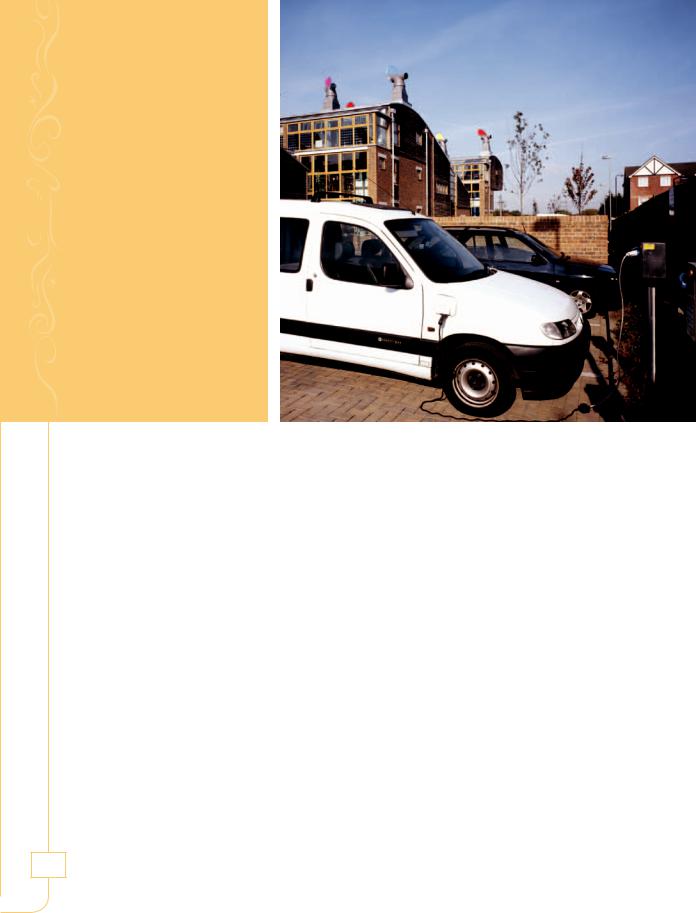
Drivers with electric cars can use outdoor outlets to charge their car batteries.
BedZED is centrally located near buses and trains, making it easy for residents to use public transportation.
Seven Wonders of Green Building Technology
Low-Carbon Transportation
Most cars burn gasoline. They give off carbon dioxide and add to global warming. The amount of carbon dioxide that a vehicle or building releases is called its carbon emissions. BedZED’s goal is to reduce carbon emissions from vehicle use by 50 percent.
To reach this goal, BedZED discourages its residents from using gasolinepowered cars. The development contains office spaces for one hundred workers. Some people who live in BedZED work in these offices. They can walk or ride bikes to work instead of driving cars. BedZED also has a day care center. Parents and children can walk or bike there too. The walkways around BedZED are well lighted, so people feel safe walking at night.
Not everyone works at BedZED. Some people must travel to jobs in London or another city. The community has organized carpools so that people can share rides to work. Some people at BedZED take buses and trains to work and school. By sharing cars and taking public transportation, people at BedZED cut down on pollution and carbon emissions.
BedZED has forty parking spaces for electric cars. The parking spaces have electric outlets. The electricity comes from BedZED’s solar panels. People can plug in electric cars to recharge the batteries. Plug-in electric cars are not very common.
12

Eco-housing
An ecosystem is a community of living and nonliving things that support and depend on one another. For instance, in a forest ecosystem, some animals eat plants.They digest the plants and make dung, or waste. This waste eventually breaks down. It adds nutrients to the soil. Nutrients in the soil help plants grow. Animals eat the plants, and the cycle continues.
People who use green construction want to imitate the natural world. They want to create housing and other buildings that work in harmony with the surrounding ecosystem. People sometimes use the term eco-housing to refer to this kind of construction.
But many companies plan to sell these cars in the 2010s. When they do, the people at BedZED will be ready.
Living in BedZED
Living in BedZED is a lot like living in a regular house or apartment. The homes include bedrooms, sun lounges, living rooms, dining rooms, and kitchens. Some have outdoor patios, with private walkways and gardens.
On the inside, BedZED’s houses and apartments look just like ordinary homes. But green building technology makes these homes much more energy efficient.

Left: Natural light floods a BedZED home during the daytime. Below: Lots of people in this eco-village know their neighbors. BedZED residents share a sense of community.

An enclosed porch in BedZED sports many flourishing plants. Many people in this green community like to tend their own small gardens.
BedZED makes it easy for residents to be environmentally friendly. All homes have lighting fixtures and appliances that don’t use much energy. Homes also have built-in recycling bins for aluminum, glass, and other materials. When the bins are full, residents simply empty them at the BedZED recycling center.
BedZED homes offer comfort and style. Some people who live there are just as attracted to the beauty of the place as the environmental features. Many residents have become good friends. Their special green village has helped them form a bond.
“Green buildings are making giant strides now because of public debate and new technology.”
BedZED
—Herbert Girardet, urban planner, 2007 |
15 |
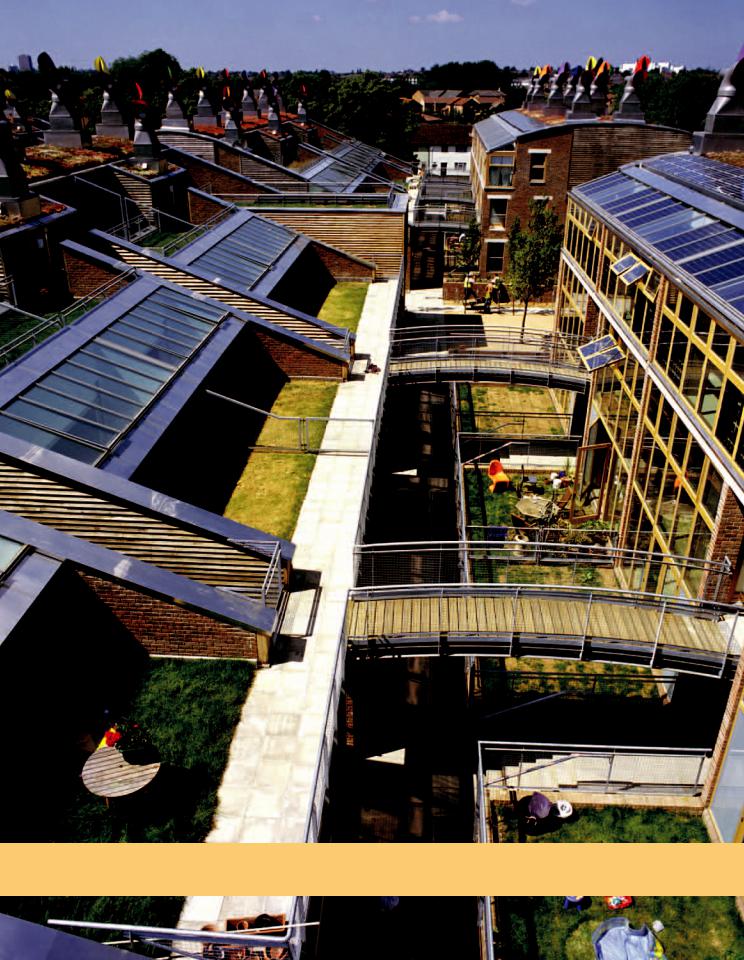
Residents enjoy little rooftop lawns and can grow their own vegetables and flowers if they wish. Bridges connect the buildings, enhancing the sense of community among the people who choose to call BedZED home.
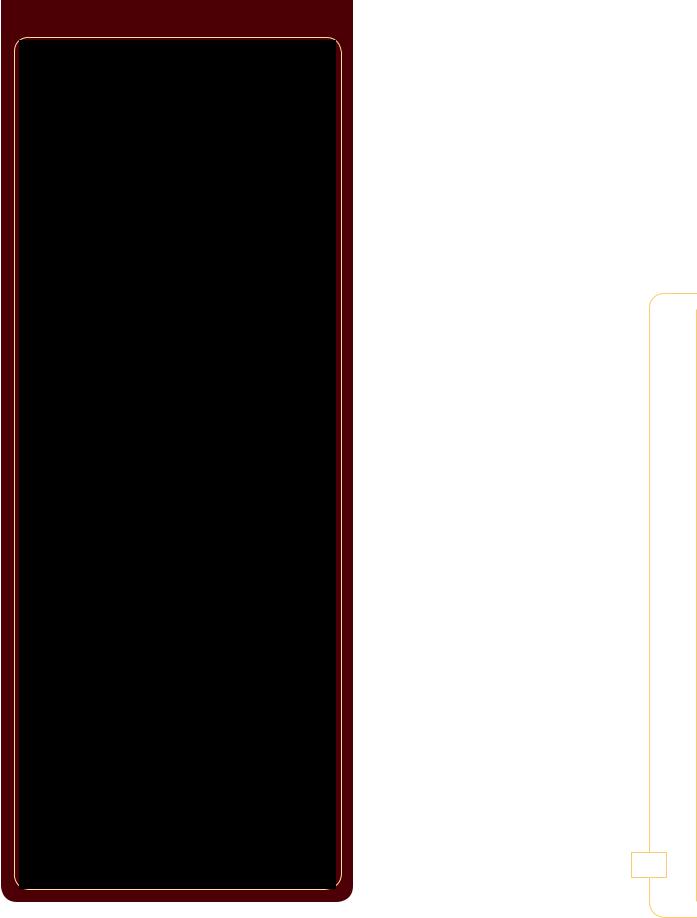
The Ford
Rouge Center’s
Living Roof
In 2004 the Ford Motor Company reopened one of its oldest car factories. Called the Ford Rouge Center, the factory is in Dearborn, Michigan.The building has many green features. One of the most striking is its living roof.
Ordinary factory roofs are covered with shingles or metal.These hard surfaces allow rainwater to run off the rooftop quickly. Factory roofs are often coated in dirt and grime from the factory. When rain falls on an ordinary factory rooftop, the rainwater picks up dirt and pollution.The dirty water eventually flows into lakes and rivers.
Putting plants on rooftops instead of shingles or metal helps prevent this kind of pollution.The plants trap dust and dirt, so they don’t wash away in the rain. And plants absorb carbon dioxide, which helps reduce a building’s carbon footprint.
The Ford Rouge Center has the largest living roof in the world. It stretches across 10 acres (4.2 hectares). It is planted with sedum.This colorful, lowgrowing plant can survive even without much rainfall. Birds and insects make their homes in the sedum. Best of all, the living roof is constantly working to purify water and air.
Carbon Savings
Despite its environmentally friendly features, BedZED still creates pollution. Some residents drive gasoline-powered cars. In addition, the CHP does not always work properly. When this happens, residents must use electric boilers powered by fossil fuels.
BedZED still puts carbon into the atmosphere, but it also takes carbon away. How do you get rid of carbon? Trees and other plants absorb carbon dioxide. Plants need carbon dioxide to live and grow. So people can offset their carbon emissions by planting trees and gardens.
The designers at BedZED have put gardens in interesting places— on the roofs of buildings. A garden on a rooftop is called a living roof. The living roofs at BedZED absorb carbon dioxide. They reduce the overall amount of carbon that BedZED releases into the air.
Because of its design, BedZED uses a lot less energy than other places. The houses use 88 percent less heat than other homes in
the United Kingdom. People in BedZED drive cars 65 percent less than other British people. That is a big carbon savings.
BedZED
17
